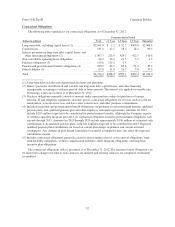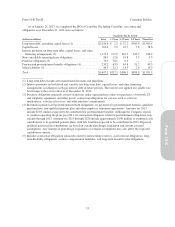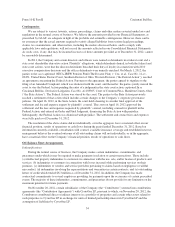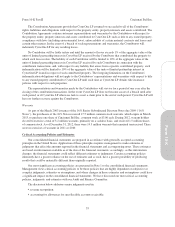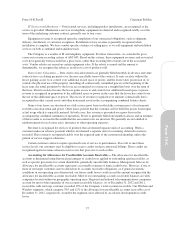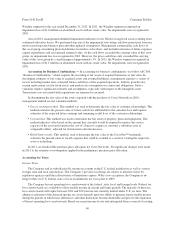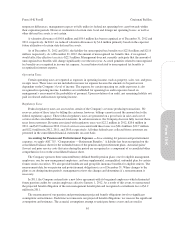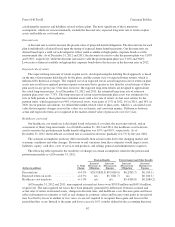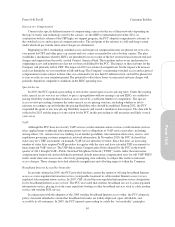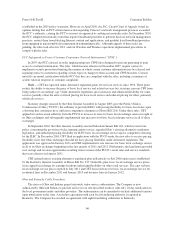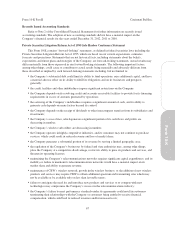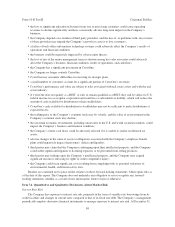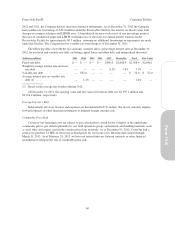Cincinnati Bell 2012 Annual Report Download - page 134
Download and view the complete annual report
Please find page 134 of the 2012 Cincinnati Bell annual report below. You can navigate through the pages in the report by either clicking on the pages listed below, or by using the keyword search tool below to find specific information within the annual report.Wireline segment for the year ended December 31, 2012. In 2011, the Wireline segment recognized an
impairment loss of $1.0 million on abandoned assets with no resale value. No impairments were recognized in
2010.
Also in 2012, management identified impairment indicators for its Wireless long-lived assets resulting from
continued subscriber losses. We performed step one of the impairment tests using cash flow projections from our
most recent long-term business plan and other updated assumptions. Management estimated the cash flows of
this asset group considering projected declines in wireless subscribers, and included estimates of future expenses,
capital expenditures and an estimated terminal value. As the cash flows exceeded the carrying value of this asset
group, no impairment loss was recognized in 2012. However, the gross cash flows only exceeded the carrying
value of this asset group by a small margin of approximately 3%. In 2011, the Wireless segment recognized an
impairment loss of $1.1 million on abandoned assets with no resale value. No impairments were recognized in
2010.
Accounting for Business Combinations — In accounting for business combinations, we follow ASC 805,
“Business Combinations,” which requires the recording of net assets of acquired businesses at fair value. In
developing estimates of fair value of acquired assets and assumed liabilities, management analyzes a variety of
factors including market data, estimated future cash flows of the acquired operations, industry growth rates,
current replacement cost for fixed assets, and market rate assumptions for contractual obligations. Such a
valuation requires significant estimates and assumptions, especially with respect to the intangible assets.
Transaction costs associated with acquisitions are expensed as incurred.
In determining the fair value of the assets acquired with the purchase of Cyrus Networks in 2010,
management utilized several valuation methods:
•Excess earnings method: This method was used to determine the fair value of customer relationships. This
method estimates the present value of future cash flows attributable to the customer base and requires
estimates of the expected future earnings and remaining useful lives of the customer relationships.
•Cost method: This method was used to determine the fair value of property, plant and equipment. This
method indicates value based on the amount that currently would be required to replace the service
capacity of the asset and considers the cost of a buyer to acquire or construct a substitute asset of
comparable utility, adjusted for deterioration and obsolescence.
•Relief-from-royalty: This method, used to determine the fair value of the CyrusOne™ trademark,
estimates the present value of royalty expense that could be avoided as a result of owning the respective
asset or technology.
In 2011, we finalized the purchase price allocation for Cyrus Networks. No significant changes were made
in 2011 to the estimates or assumptions applied in the preliminary purchase price allocation.
Accounting for Taxes
Income Taxes
The Company and its subsidiaries file income tax returns in the U.S. federal jurisdiction as well as various
foreign, state and local jurisdictions. The Company’s previous tax filings are subject to normal reviews by
regulatory agencies until the related statute of limitations expires. With a few exceptions, the Company is no
longer subject to U.S. federal, state or local examinations for years prior to 2009.
The Company has net operating loss carryforwards at the federal, state, local and foreign levels. Federal tax
loss carryforwards are available to offset taxable income in current and future periods. The majority of these tax
loss carryforwards will expire between 2021 and 2023 and are not currently limited under U.S. tax laws. The
ultimate realization of the deferred income tax assets depends upon our ability to generate future taxable income
during the periods in which basis differences and other deductions become deductible and prior to the expiration
of the net operating loss carryforwards. Based on current income levels and anticipated future reversal of existing
60
Form 10-K Part II Cincinnati Bell Inc.




